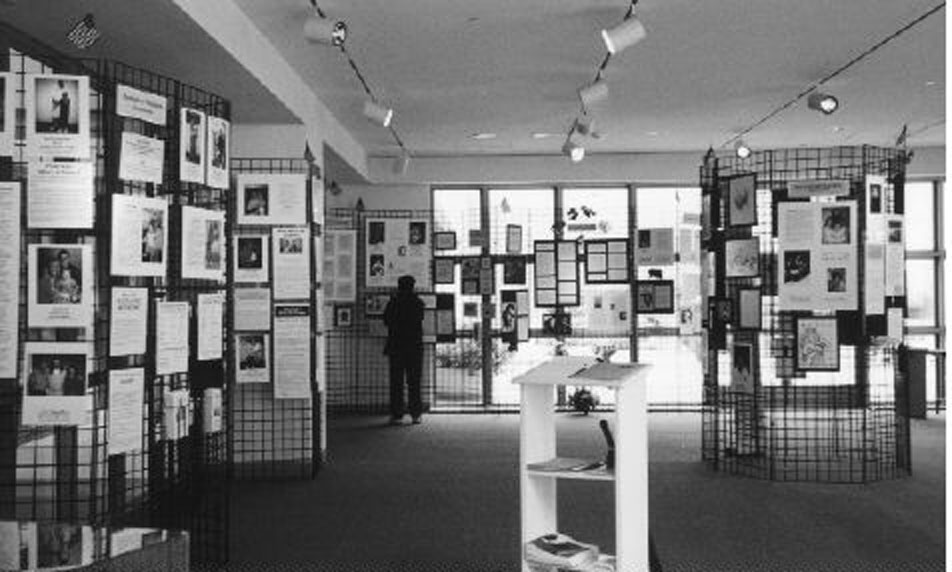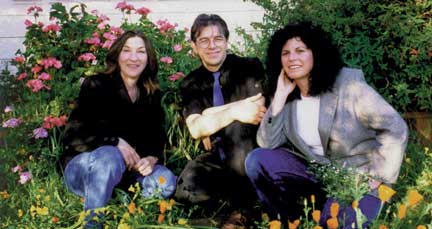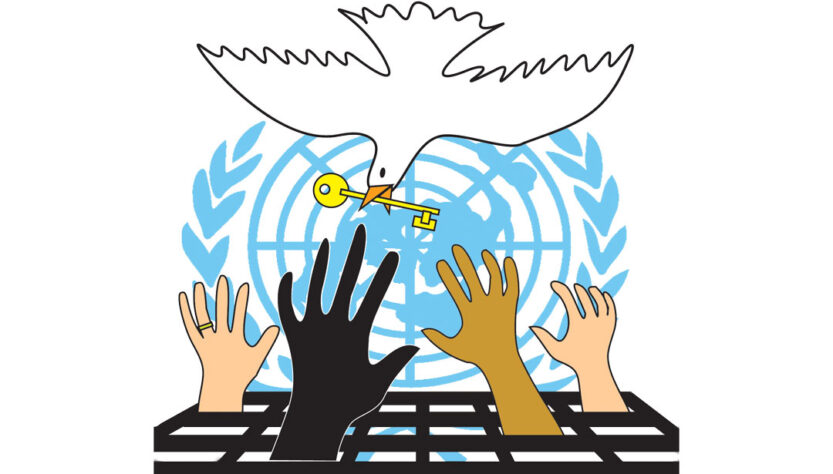Human Rights and the Drug War is a multi-media project that combines the stories and photos of Drug War POWs with facts and figures about the US Drug War, to confront the conscience of the American people and encourage individuals to take action for social justice. We hope that, when they see the faces of the Drug War, people will turn against it and support Human Rights.

It began as a photo and information exhibition in San Francisco for the 50th Anniversary of the founding of the United Nations. The collection was reproduced into dozens of other displays and formats shown around the USA and Europe, put into PowerPoint and slide presentations and developed into two books.
- Laminated Display: The customized laminate display
- Exhibition: How to sponsor an exhibit showing
- Photo book: Shattered Lives: Portraits From America’s Drug War
- UDHR book: Human Rights and the US Drug War
- Internet: Faces & stories: Drug War photo gallery
- Slide Show: Scripted slide presentation for organizations
- Exhibition: Display topics
- Coming Soon: Powerpoint presentations
- History: Where the exhibit has been shown
- History: The people behind the project
- HOME
Display sections and topics
The HRDW exhibition is a multi-media project that combines the stories and photos of Drug War POWs with facts and figures about the US Drug War, to confront the conscience of the American people and encourage individuals to take action for social justice.
- Introduction to Human Rights and the Drug War
- UN Universal Declaration of Human Rights violations (excerpts from this document and the U.S. Bill of Rights are contrasted with the abuses of the Drug War)
- Prisoners of War Wall (with photos, case histories that illustrate various issues)
- Information and charts (mandatory minimum sentencing data, prison growth, incarceration rates, private prisons,social and financial costs, etc.)
- What about the children? Photos and quotes by incarcerated parents
- Cultural / Religious Prisoners of Conscience
- Asset Forfeiture
- Medical Marijuana (Highlights prisoners, case histories, overview of present policies)
- The tragedies (A memorial to the victims killed by law enforcement agents and others who have died as a result of the Drug War)
- Drug testing
Original, museum quality exhibit
The Human Rights and the Drug War (HR 95) display was originally titled, “Atrocities of the Drug War.” It contained approximately the same content as the current, laminated version, but it was made of different materials. Its configuration was flexible, but in its entirety, the exhibit was quite large, requiring approx. 800 sq. ft. of space. Individual topic sections made complete statements, so it was set up and displayed according to thematic sections, or the entire exhibit was selectively pared down to suit the needs of a particular setting or event. Since it took nearly five hours to set up, and expensive to ship, it is rarely used these days.
Physical Specifications of the Museum-scale HRDW Display
- Approx. 230 separate pieces of various sizes, professionally mounted on foam core, with Velcro mounting brackets attached for easy assembly and disassembly.
- Over half of the exhibit consists of photographs and graphics (statistical charts, graphs, artwork, etc.).
- The remainder is text, poetry, personal writings, letters, etc.
- Items may be adapted for mounting on other appropriate surfaces (as approved by the Human Rights and the Drug War coordinators).
- Assembles onto 55 display metal grids, 2′ wide X 8′ tall each, attachable or free-standing.
- Setup time is approximately four to six hours, with a crew. Tear down is much faster, although pieces also need to be repackaged for transportation.
Return to Human Rights and the Drug War
The People Behind the Project

Human Rights and the Drug War was originally known as Human Rights 95 (HR 95) and is centered around a photo exhibit showing the faces and telling the stories of victims of US drug policy. This exhibit was the basis for the book entitled, Shattered Lives: Portraits from America’s Drug War, published by Creative Xpressions. The book was written by the exhibit’s creators and coordinators, Mikki Norris, Chris Conrad, and Virginia Resner. They also collaborated on a smaller book entitled Human Rights and the Drug War, that analyzes our drug policies in the context of the United Nations’ Universal Declaration of Human Rights and the US Constitution. At the annual conference of the Lindesmith Center/ Drug Policy Foundation, these three, hardworking individuals were presented with the 2001 Robert C. Randall Award in the Field of Citizen Action for their work in putting a “human face” on the Drug War. Norris later founded the Cannabis Consumers Campaign. With her husband, Chris Conrad, she was a prominent supporter of both California’s failed Proposition 19 (2010) effort and the successful Proposition 64 (2016), which finally legalized cannabis for adults in the state.
Mikki Norris is creator, curator, and co-coordinator of the Human Rights and the Drug War Exhibit Project. Ms. Norris has a Masters Degree in Special Education and is a researcher on drug policy as well as numerous peace and justice issues. She is involved in the Family Council on Drug Awareness (FCDA), a public policy think tank which researches and develops materials on drug-related topics. As community action co-coordinator for Californians for Medical Rights, she helped organize petitioners to qualify the California Medical Marijuana Initiative (Prop. 215) for the 1996 ballot. Ms. Norris advocates harm reduction and tolerance policies to reduce drug abuse while protecting families and civil liberties. She has traveled around the US, the Americas and Europe collecting information and networking with hundreds of groups and individuals that are involved with drug policy reform.
Virginia Resner was California coordinator for Families Against Mandatory Minimums (FAMM), who organized local public events and meetings to muster public support for changing sentencing laws. Born and raised in a progressive activist family in San Francisco, Ms. Resner’s father was a labor lawyer. She provided information and support through correspondence to prisoners and their families, to public officials and media. She joined FAMM in 1991 after her boyfriend was arrested by federal agents and her home raided in a warrantless search. She lobbied in Washington DC to change mandatory sentencing laws and began working on the FAMM Women’s Project when she realized how many women are being targeted by current policy. An experienced public speaker, she was drawn into HR95 due to her empathy and desire to help form support systems for families of prisoners. Resner passed away from illness in 2007.
Chris Conrad is production and art director, editor and writer for the Human Rights and the Drug War Exhibit Project. He is author of Hemp, Lifeline to the Future and Hemp for Health, director of the Business Alliance for Commerce in Hemp (BACH) and the Family Council on Drug Awareness, designing curator of the Hash / Marihuana / Hemp Museum of Amsterdam, and past president of the Hemp Industries Association. A regular guest on talk shows around the country, Mr. Conrad is an internationally recognized expert and consultant on topics related to cannabis and prohibition, and has met with and given presentations to groups including government officials in the US, Canada, Holland, Germany, Argentina, Uruguay, China, Mexico and other countries. As Californians for Medical Rights’ Community Action Coordinator, he organized grassroots activist groups statewide to petition and qualify the Medical Marijuana Initiative (Prop 215) for the ballot. He went on to form Safe Access Now for medical marijuana patient rights and was active in the writing of California’s SB 420, the first state law to legalize cannabis sales. He addressed a special hearing of the UN Committee on Reorganization about human needs, and has testified at numerous state and local government hearings on this and related topics. He has been recognized as an expert witness on cannabis in the courts of California, other states and the federal government and worked on more than 2500 cases. With his wife, Mikki Norris, he was a prominent supporter of both California’s failed Proposition 19 (2010) effort and the successful Proposition 64 (2016), which finally legalized cannabis for adults in the state.
